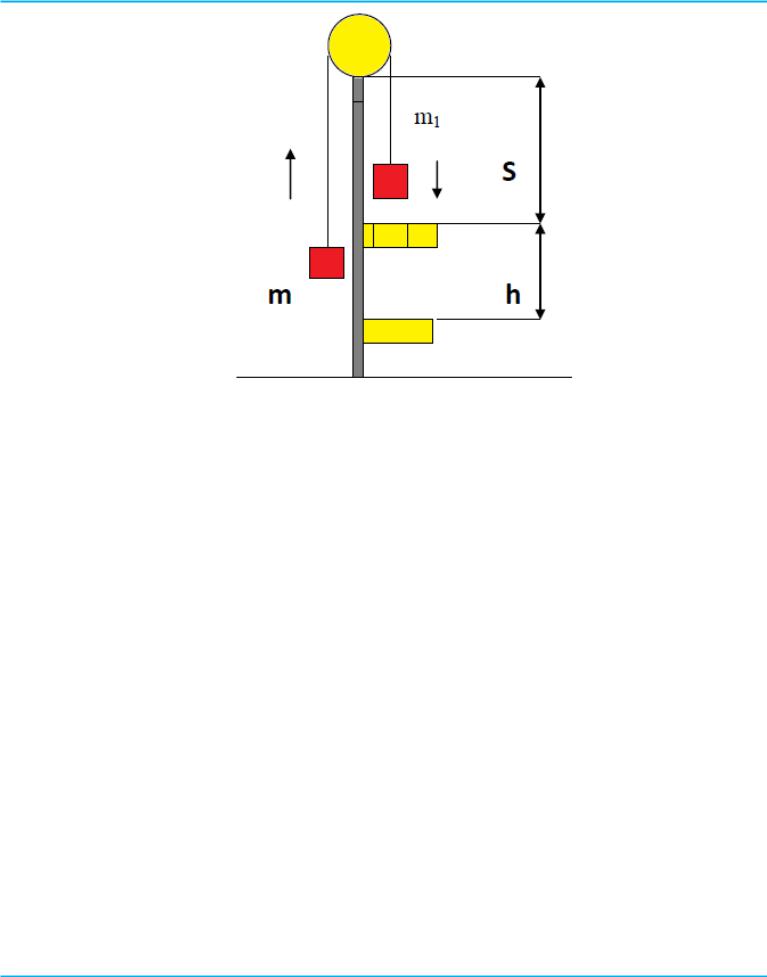

Laboratory Work #1
STUDY OF KINEMATICS AND DYNAMICS
ON THE ATWOOD’S MACHINE
PhysicVirtualLab Software Package
LABORATORY WORK #1
STUDY OF KINEMATICS AND DYNAMICS
ON THE ATWOOD’S MACHINE
1. AIM OF THE WORK:
investigation of kinematical equations for straight line and uniformly accelerated motions;
study of main dynamics equation of point particle and translational motion of rigid body.
TASKS:
Straight line velocity determination of the load using Atwood’s machine.
Determination of acceleration for the uniformly accelerated motion of the load.
Newton’s second law verification.
2. INTRODUCTION
Motion of mechanical system (Fig.1) is described by the laws of Newtonian’s classical mechanics. The mechanical system consists of two loads with masses m and , which are connected by unstretchable line. Where r is radius of pulley,
moment of inertia is J and is mass of overload.
The potential energy of the mechanical system does not depend on the loads position if the masses of the loads are equal. It comes from the fact that the loss of the potential energy of the first body results the correspondent potential energy increase of the second one. If the loads have different masses, variation of the mechanical system’s potential energy is defined by changing position of overload :
. (1)
Potential energy of the system transforms into kinetic energy of translational and circular motion of the system (work to overcome the gravity can be neglected):
PhysicVirtualLabs Project Team, IITU
Copyright 2014

Laboratory Work #1
STUDY OF KINEMATICS AND DYNAMICS
ON THE ATWOOD’S MACHINE
PhysicVirtualLab Software Package
|
|
|
|
[ |
( |
) |
], (2) |
|
|
|
||||
|
|
|
|
|
|
|
|
|
|
|
||||
|
|
|
|
|
|
|
|
|
|
|
||||
where |
|
|
is kinetic energy of the left load (without overload); |
( |
) |
is kinetic |
||||||||
|
|
|
|
|
||||||||||
energy of the right load (with overload); |
|
is kinetic energy of pulley’s circular |
||||||||||||
|
||||||||||||||
motion. |
|
|
|
|
|
|
|
|
|
|
|
|
|
|
Taking into account, that |
|
|
and angular velocity is |
|
, linear velocity |
|||||||||
|
|
|
||||||||||||
is |
, radius of the rotating |
disc is r, it |
is possible to get expression for the |
|||||||||||
determination of acceleration of the system in the following form:
|
|
. (3) |
( |
) |
If we neglect pulley’s moment of inertia J, The formula for the acceleration has the form:
|
|
|
|
, (4) |
( |
) |
|
||
|
|
|
where M is total mass of the system and |
is mass of overload. |
After taking off the overload, the loads will move uniformly with velocity v, which is constant for the standing distance S:
|
|
|
|
|
|
|
. (5) |
|
|
|
|
|
|
|
|
|
|
||
For the uniformly accelerated system without initial velocity |
the acceleration |
||||||||
is equal to |
|
, where v is finite velocity, which is equal to velocity of uniformly |
|||||||
|
|||||||||
motion and therefore it can be find by formula |
|
. The final expression for the |
|||||||
|
|||||||||
determination of the acceleration is written as
PhysicVirtualLabs Project Team, IITU
Copyright 2014

Laboratory Work #1
STUDY OF KINEMATICS AND DYNAMICS
ON THE ATWOOD’S MACHINE
PhysicVirtualLab Software Package
. (6)
One of the methods to prove Newton’s second law is verification of relation (4). Thereto the total mass of the system М has to be constant, but the magnitude of the acting force has to be changed:
, (7)
where , …are masses of overload.
3. EXPERIMENTS DESCRIPTION
Atwood’s machine consists of vertical stand with scale ruler. The three supporting arms are fixed on this scale ruler (the upper supporting arm with constant fixation is not shown in figure 1). On the stand is set up electromagnet and light pulley, which is able to rotate with insignificant friction. Over the pulley is thrown over the light string with the same mass m. Electromagnet holds the pulley with loads in the rest. Middle supporting arm is furnished by ring for taking off the overload m1. At the moment when the load m moves over the ring, the timer is switch on. The timer measures time t of uniformly motion of loads on the path h. Measuring the distance, which was passed by the load with uniformly accelerated S motion and uniformly h motion, respectively, also the time t, it is possible to prove the main laws of kinematics and dynamics for translational motion and to calculate the free fall acceleration.
PhysicVirtualLabs Project Team, IITU
Copyright 2014

Laboratory Work #1
STUDY OF KINEMATICS AND DYNAMICS
ON THE ATWOOD’S MACHINE
PhysicVirtualLab Software Package
Figure 1- Atwood’s machine
Procedure:
3.1Start the program by clicking two times on the icon of the program.
3.2On the interface of the project you see the following four buttons:
“Theory”, “Lab”, “Tests” and “Exit”.
3.3Read the theory of the experiment.
3.4At the window “Lab” you can see the main parameters of the experiment as length of ruler, mass of load, mass of overload and number of measurements. Enter the parameters according to your individual task from teacher. Click the button “Start”.
Task 1. Study of uniformly motion
3.5 Set up the height h of the uniformly motion of the load. Start with the magnitude 21 and then click the button “Run”. You receive the readings for t in the table and on the timer. Repeat the experiment for the changed height. It changes automatically for one magnitude.
PhysicVirtualLabs Project Team, IITU
Copyright 2014

Laboratory Work #1
STUDY OF KINEMATICS AND DYNAMICS
ON THE ATWOOD’S MACHINE
PhysicVirtualLab Software Package
3.6 Write down the reading of h and t in table1. Please use SI units.
Table 1 - Readings of the task 1
h, m |
t, sec |
v, m/sec |
|
|
|
|
|
|
3.7 |
Prove the relation |
|
. |
|
|
|
|||
3.8 |
Find the mean value |
|
, absolute error of velocity |
and relative error ε |
(%) by Student’s method. Write the last result for the velocity as
.
Task 2. Study of uniformly accelerated motion
3.9By changing the positions of support arms, set up distance of uniformly motion S and uniformly accelerated motion h of load.
3.10Measure time of uniformly motion of load t for different distances between support arms h.
3.11Write down the reading of S, h and t in table 2. Please use SI units.
Table 2 – Readings of the task 2
S, m |
h, m |
t, sec |
a, m/sec2 |
|
|
|
|
|
|
|
|
3.12 Calculate the acceleration |
|
for different values of S and h. |
|
PhysicVirtualLabs Project Team, IITU
Copyright 2014

Laboratory Work #1
STUDY OF KINEMATICS AND DYNAMICS
ON THE ATWOOD’S MACHINE
PhysicVirtualLab Software Package
3.13 Find the mean value , absolute error of acceleration and relative error ε (%) by Student’s method. Write the last result for the velocity as
.
Task 3. Verification of Newton’s second law
3.13Set up distance h of uniformly accelerated motion of load.
3.14Set up mass of overload on the right load between 30 and 50 grams. (Since m=const, on the left load overload is 30 gram and net overload m1 is 10 gram.)
3.15Measure time t of uniformly motion of load at different magnitudes of h. Write down the readings in table 3. Calculate the acceleration a. Please use SI units.
Table 3- Readings of the task 3
m, kg |
h, m |
t, sec |
a, m/sec2 |
|
|
|
|
|
|
|
|
3.16 |
Check the relation |
|
|
|
, where |
, |
are masses of |
||
|
|
||||||||
|
overloads. |
|
|
|
|
|
|
|
|
3.17 |
Calculate the relative error of measurements for the relation |
|
. |
||||||
|
|||||||||
3.18 Using the obtained results formulate the report and make conclusions for every task with pointing out the errors of experiment.
4QUESTIONS:
1.1Give the definition of the velocity, average velocity, and instantaneous velocity.
PhysicVirtualLabs Project Team, IITU
Copyright 2014

Laboratory Work #1
STUDY OF KINEMATICS AND DYNAMICS
ON THE ATWOOD’S MACHINE
PhysicVirtualLab Software Package
1.2What is the uniformly accelerated motion?
1.3Give the definition of the acceleration. Write the main equation.
1.4What is the free motion?
1.5Write the main equation of the gravity acceleration.
1.6Give the definition and write the equation of the path of the uniform motion.
1.7Give the definition and write the equation of the path of the uniformly accelerated motion without the initial velocity.
1.8Give the definition and write the equation of the path of the uniformly accelerated motion with the initial velocity.
1.9Give the definition and write the equation of the force.
1.10Mass is the measure of the inertia. Explain the sense of this expression.
1.11Get the equation of the acceleration of the gravity.
1.12Why the Atwood’s machine leads to measure the gravity at the small distances, passing by the falling body?
5REFERENCES:
5.1Raymond A. Serway, John W. Jewett Physics for Scientists and Engineers, 2006.
5.2Irodov I.E. Fundamental laws of mechanics, 2001.
PhysicVirtualLabs Project Team, IITU
Copyright 2014
